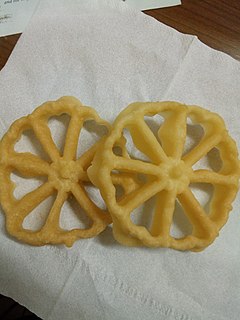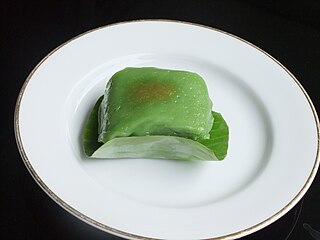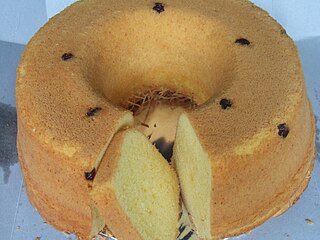
A pancake is a flat cake, often thin and round, prepared from a starch-based batter that may contain eggs, milk and butter and cooked on a hot surface such as a griddle or frying pan, often frying with oil or butter. It is a type of batter bread. Archaeological evidence suggests that pancakes were probably eaten in prehistoric societies.

A crêpe or crepe is a very thin type of pancake. The first recorded recipe for Crêpes originates from Brittany, a region in western France, during the 13th century, and are now consumed around the world. Crêpes are usually one of two varieties: sweet crêpes or savoury galettes. They are often served with a wide variety of fillings such as jam or hazelnut cocoa spread. Crêpes can also be flambéed, such as in crêpes Suzette.

Kuih are bite-sized snack or dessert foods commonly found in Southeast Asia and China. It is a fairly broad term which may include items that would be called cakes, cookies, dumplings, pudding, biscuits, or pastries in English and are usually made from rice or glutinous rice. In China, where the term originates from, kueh or koé in the Min Nan languages refers to snacks which are typically made from rice but can occasionally be made from other grains such as wheat. The term kuih is widely used in Malaysia, Brunei, and Singapore, kueh is used in Singapore and Indonesia, kue is used in Indonesia only, all three refer to sweet or savoury desserts.

A pannenkoek or Dutch pancake is a style of pancake with origins in the Netherlands. Pannenkoeken are usually larger and much thinner than their American or Scotch pancake counterparts, but not as thin as crêpes. They may incorporate slices of bacon, apples, cheese, or raisins. Plain ones are often eaten with treacle, appelstroop or (powdered) sugar and are sometimes rolled up to be eaten by hand or with cutlery.

Kue is an Indonesian bite-sized snack or dessert food. Kue is a fairly broad term in Indonesian to describe a wide variety of snacks including cakes, cookies, fritters, pies, scones, and patisserie. Kue are made from a variety of ingredients in various forms; some are steamed, fried or baked. Kue are popular snacks in Indonesia, which has the largest variety of kue. Because of the countries' historical colonial ties, Koeé (kue) is also popular in the Netherlands.

Serabi, also called surabi, srabi, also known in Thailand as khanom khrok, is an Indonesian pancake that is made from rice flour with coconut milk or shredded coconut as an emulsifier. Most of traditional serabi tastes sweet, as the pancake is usually eaten with kinca or thick golden-brownish-colored coconut sugar syrup. However, another savoury version also existed that uses oncom toppings. Different provinces in various Asian countries have their own serabi recipes corresponding to local tastes.

Kue cubit is a Southeast Asian snack, originating from Indonesia. It is common snack food served in many Indonesian cities. It is a cake, around 4 centimetres (1.6 in) in diameter. The sellers of this snack usually operate near schools or traditional markets. Kue cubit uses flour, baking powder, sugar and milk as its primary ingredients. The liquid dough is poured into a steel plate with several small round basins so that it will form a round shape when cooked, and poured with meises on top of it. The sellers usually use a special hooked stick to take the cake off from the steel plate.

Kue semprong, Asian egg roll, sapit, sepit, kue Belanda, or kapit, is an Indonesian traditional wafer snack made by clasping egg batter using an iron mold which is heated up on a charcoal stove. It is commonly found in Indonesia, Malaysia, Singapore and Brunei.

Kue kembang goyang or kuih loyang is an Indonesian cuisine and Malaysian cuisine flower-shaped traditional snack (kuih), associated with Betawi cuisine and Malay cuisine.

Kue bugis is Indonesian kue or traditional snack of soft glutinous rice flour cake, filled with sweet grated coconut. The name is suggested to be related to Bugis ethnic group of South Sulawesi as their traditional delicacy, and it is originated from Makassar. In Java the almost identical kue is called kue mendut. Kue bugis, together with kue lapis and nagasari are among popular kue or Indonesian traditional sweet snacks, commonly found in Indonesian traditional marketplace as jajan pasar.

Kue ape or serabi Jakarta is a popular traditional kue pancake with soft and fluffy center surrounded with thin and crispy crepes, commonly found as a popular street food in Indonesia, especially in Jakarta and other major cities. It is also popularly known as kue cucur tipis, which is different from the thicker kue cucur, and colloquially known as kue tetek due to its shape that resembles a nipple. Because it is deemed inappropriate to say ‘tetek’, most Indonesians just say kue ape as in “what cake?”. It is also very similar to serabi Solo.

Bolu kukus is an Indonesian traditional snack of steamed sponge cupcake. The term "bolu kukus" however, usually refers to a type of kue mangkuk that is baked using mainly wheat flour with sugar, eggs, milk and soda, while also using common vanilla, chocolate, pandan or strawberry flavouring, acquired from food flavouring essence. The cake makes use of beaten eggs and soda as an emulsifier, the type of soda often being lemon sparkling water, such as Sprite.

Dadar gulung is a popular traditional kue of sweet coconut pancake. It is often described as an Indonesian coconut pancake.

Kue pukis or simply called Pukis is an Indonesian kue or traditional snack made of a wheat flour-based batter and cooked in a special mold pan. It is a commonly found snack in Indonesian traditional markets.

Kue talam is an Indonesian kue or traditional steamed snack made of a rice flour, coconut milk and other ingredients in a mold pan called talam which means "tray" in Indonesian. The cake mold used to create kue talam are either larger rectangular aluminium tray or smaller singular cups made from ceramics, aluminium, melamine or plastic.

Kue bangkit is a small biscuit that made from sago starch of Malay origin, commonly found in Indonesia and Malaysia. This biscuit has various colours, ranging from white, yellowish to brown, depends on the additional ingredients.

Indo cuisine is a fusion cooking and cuisine tradition, mainly existing in Indonesia and the Netherlands, as well as Belgium, South Africa and Suriname. This cuisine characterized of fusion cuisine that consists of original Indonesian cuisine with Eurasian-influences—mainly Dutch, also Portuguese, Spanish and British—and vice versa. Nowaday, not only Indo people who consume Indo cuisine, but also Indonesians and Dutch people.

Kue putu mayang is an Indonesian Betawi string hopper dish made of starch or rice flour and coconut milk, then shaped like noodles. This noodle-like dish served with kinca in Betawi and Javanese cuisine, or with chutney or curry in Indian Indonesian cuisine.

Kue bolu or simply Bolu is an Indonesian term to describes a wide variety of sponge cakes, tarts and cupcakes.





















